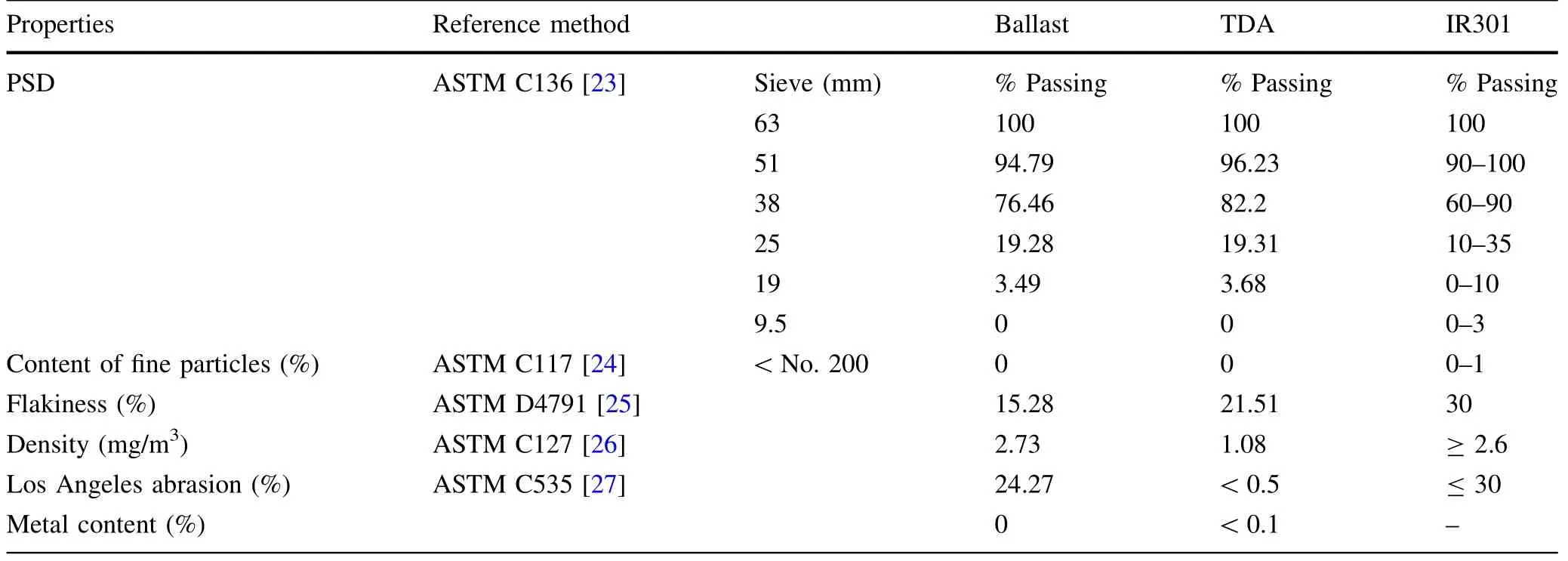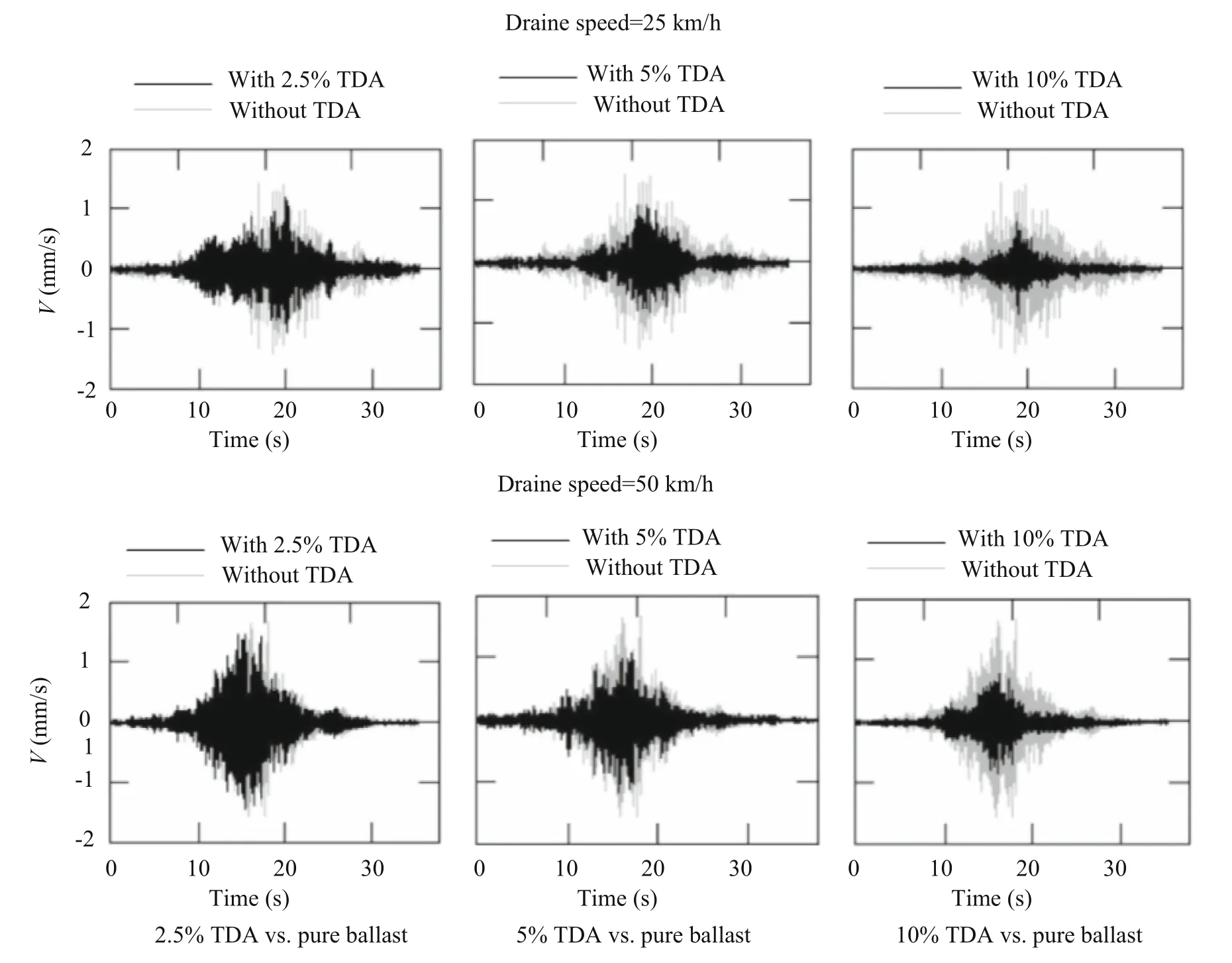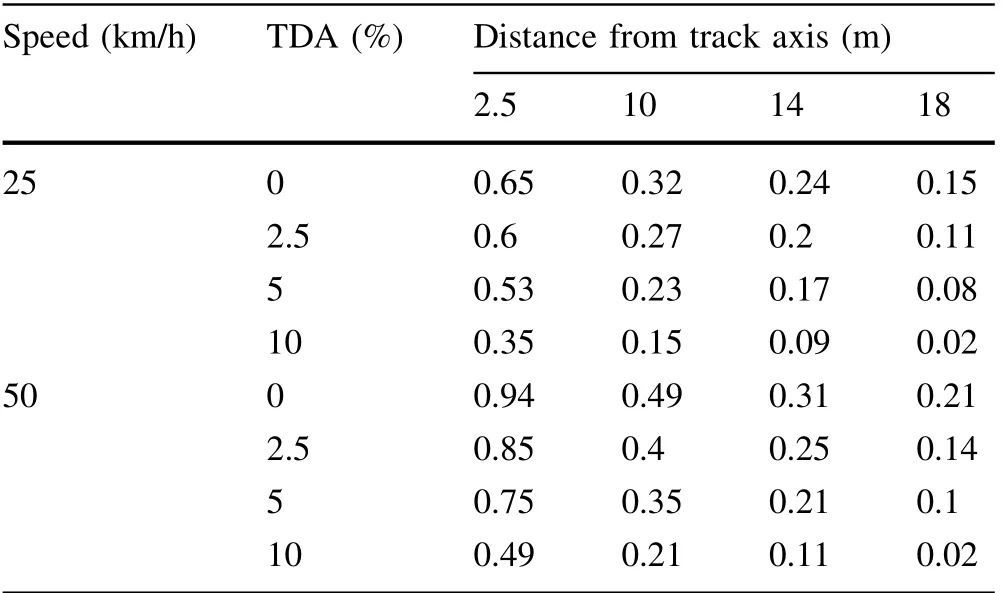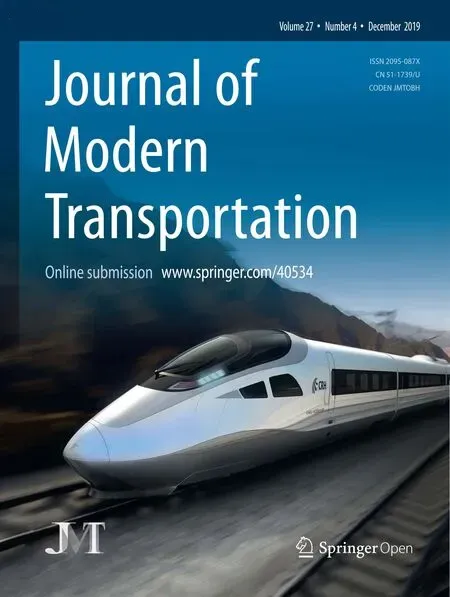Influence of tire-derived aggregates mixed with ballast on groundborne vibrations
Masoud Fathali· Morteza Esmaeili· Fereidoon Moghadas Nejad
Abstract In this paper, the use of recycled tire-derived aggregates (TDA) mixed with ballast material is evaluated in order to reduce the train-induced ground-borne vibrations. For this purpose, a series of field vibration measurements has been carried out at an executed pilot track.The prepared ballast layer was mixed with different percentages of TDA in three sections. Moreover, another test section with pure ballast is considered as a reference. The vibrations generated by a motor-powered draisine at two different speeds are then recorded. Records of vibration data are provided using four seismometers placed once longitudinally and once transversely beside different sections.The outputs are then processed in both velocity-time and velocity-frequency domains. To verify the vibration mitigation performance of TDA in real operation conditions,field measurements under the passage of two planned passenger and freight trains are finally arranged. Results show that the best TDA mixture ratio,i.e.,10%by weight,can reduce the transmitted vibrations up to 12 dB for frequencies above 31.5 Hz. According to the obtained efficiency and the very low cost of the recycled materials,this solution can be considered as a competitive vibration countermeasure.
Keywords Railway track · Ballast · Tire-derived aggregates (TDA) · Ground-borne vibrations
1 Introduction
Ground-borne vibrations induced by train traffic have undesirable impacts on adjacent sensitive structures and may cause disturbance of the surrounding occupants. This problem is one of the most important and complex environmental issues in the design and operation of the railway tracks,especially due to heavier operation loads and higher speeds of passing trains. Produced vibrations can cause some destructive effects on the existing structures and neighboring sensitive facilities and may lead to the degradation of track sub/superstructure components,which imposes higher maintenance and repair costs [1]. Hence,the vibration mitigation approach has been addressed by many standards and organizations to different railways[2].To control the negative effects of vibrations, different types of actions have been proposed. One of the main categories of vibration attenuation at source is the modification of track structure with insulating elements [3].Under-sleeper pad (USP), under-ballast mat (UBM), the floating slab, and full tire-derived aggregate (TDA) subballast can be addressed as the most well-known solutions.For example, studies by International Union of Railways(UIC) [4] and Zakeri et al. [5] have shown that groundborne vibrations can reduce effectively by USP from a frequency above 40 Hz with an insertion loss between 8 and 15 dB. The effectiveness of UBM in controlling vibrations has also been studied by different organizations such as UIC [6]and Federal Transit Administration (FTA)[7].The results showed that in general,the performance of UBM has been found to be satisfactory and this insulating layer can reduce vibrations by 10 to 15 dB at frequencies between 25 and 30 Hz, and by 8 to 18 dB at frequencies above 63 Hz. The performance of floating slabs in mitigating the vibrations has also been assessed by many researchers and organizations [2, 3, 7, 8]. Studies have shown that this method is effective by at least 15 dB at frequencies above 15 to 20 Hz and is mostly used in the case of underground railways which are characterized by its high-frequency content compared with surface railway traffic on soft soil [8].
In the same way, some vibration reduction countermeasures have been proposed with the use of full TDA as sub-ballast layer.For example,Cho et al.[9]confirmed the reduction effect of full TDA layer on environmental vibration in Honam and Gyeongbu rail lines. Results indicated that in the case of using TDA layer with 0.20 meter thickness for 23-Hz and 33-Hz vibrating sources,the vibrations reduced 16% and 30%, respectively. Towers[10] also conducted a vibration field test in Denver, USA,using the TDA as sub-ballast and concluded that this layer can provide vibration reduction of 3 dB between 25 and 31.5 Hz and up to 14 dB between 40 and 160 Hz. Moreover, Esmaeili and Rezaei [11] conducted a series of impulse-response (IR) tests on a prototype of a ballasted track with TDA sub-ballast layer. They concluded that TDA with the particle size of 5-50 mm and thickness of 0.20 m can reduce vertical vibrations at least 6 dB with the dominant frequency of more than 32 Hz.A summary of the abovementioned mitigation measures and their related vibration performances and comparative additional costs is presented in Table 1.
Besides the vibration mitigation methods mentioned,some recent studies [12-19] introduce a new approach of mixing the ballast material with TDA to increase the track resiliency, improve the damping properties, and decrease the breakage and wear of ballast particles. Based on these researches,the effects of TDA on various aspects of ballast layer including particles degradation, static and dynamic performances, and damping properties have been investigated both experimentally and numerically under normal circumstances and sand-fouled conditions. As can be seen, the capacity of ballast-TDA mixture on reduction of train-induced ground-borne vibrations is not seriously investigated, which is the goal of the current research.
This study is carried out at an under-operation railway line in Iran by using field vibration measurements.For this mean, four existing test sections of ballast layer with,respectively, 0, 2.5, 5, and 10 weighted percentages of TDA have been served. Selecting the upper limit of TDA material is based on the results of prior research studies conducted on ballast-TDA mixtures; the obvious reason for the restriction required for addition of more than 10%TDA is the reduction of shear strength as well as the increase in the long-term ballast settlement(see References[12-19]). Then, a motor-powered draisine with four different speeds is passed through the track and related vibration responses are recorded in the form of velocity.The vibration velocity measurements are taken using four molecular-electronic seismometers (known as microtremor) placed at 2.5 m distance from track axis in different test sections. For better recognition of vibration transmission in the standard privacy of rail track, these sensors in the next stage are put transversely at 2.5,10,14,and 18 m distances from track axis at each section. The outputs are then processed in two different formats of velocity-time and velocity-frequency domains, and the capability of TDA on vertical vibration reduction is discussed. Finally, as a reliable reference, the vertical vibration responses of TDA are evaluated during the passage of two passenger and freight trains and the end conclusions about the place of TDA mixed with ballast in vibration reduction measures are presented.
2 Methodology
2.1 Test track condition
An existing block between stations Raml and Jandagh along the Bafgh-Tabas railway in Eastern desert of Iran was selected for field vibration measurements. Aspresented in Fig. 1, the total length of the instrumented track was 80 m and it was divided into four sections, each of 20 m length. Ballast mixed with 2.5%, 5%, and 10%TDA was used at sections 2, 3, and 4, respectively, while section 1 was built as a reference with pure ballast(i.e.,0%TDA).The track panels included B70 sleepers(with 0.6 m center-to-center distance) which were connected to two UIC60 rails using type E-clip Pandrol fasteners.The panels were supported on a 0.40-m ballast layer with the side slopes of 1:1. The whole superstructure in this part of the railway was laid on an embankment with a height of 5 m.During the site visit,it was found that the embankment soil type was compacted clay gravel placed directly on the top of silty clay soil with the side slopes of 2:3.

Table 1 Classification of vibration mitigation measures
2.2 Instrumentation plan
As the vibration velocity is more suitable and comprehensible term compared to displacement or acceleration, it is used as the main vibration index of most railway regulations[20]. Therefore, the velocity is considered in this study to explain railway-induced vibrations. According to the instrumentation plan shown in Fig. 1,the vibration velocity measurements were taken using four molecular-electronic seismometers (CME-4011 model), with the sampling frequency band of 100 Hz.These high-gain three-axial sensors are capable of recording ground velocity motions that are too small to be felt(i.e.,weak motions).In the first step,one line of sensors was put longitudinally beside the track axis at 2.5 m distance.Moreover,to demonstrate the lateral transmission of vibrations, the sensors in the next stages were installed in the transverse direction for each section. The transverse distances from axis of the track(i.e.,2.5,10,14,and 18 m)were considered so that a full pattern of vibration transmission in the standard privacy of rail line could be recognized.

Fig. 1 Test track condition and instrumentation plan (dimensions in m)
2.3 Ballast and TDA properties
Table 2 presents the main properties of the ballast and TDA used in this study. The ballast was of dolomite type with the nominal particle size of 19 to 51 mm based on the Group 4 of gradation of Iran ballast specifications [21],similar to the Group 4 of American Railway Engineering and Maintenance of Way Association (AREMA) Standard[22].The recycled metal-free TDA was also produced from mechanical shredding of scrap truck tires. Although TDA as an artificial material was used instead of granular ballast,the main functions of the material should be maintained.To this end, TDA particle size distribution (PSD) was attempted to be identical to ballast material. As shown in Table 2, the PSD of the TDA is considered comparatively close to the crushed ballast. The sample of ballast mixture with 10% TDA as a prototype is illustrated in Fig. 2a. It should be noted that ballast and TDA were mixed together in a homogenous manner and compacted by tamping machine with more operation cycles (see Fig. 2b).
2.4 Excitation method
Two series of vibration excitation were conducted on the test track.In the first set of tests,a motor-powered draisine was passed at two different speeds of 25 and 50 km/h.Each record was repeated three times,and the average value was taken as the basis for assessments. To evaluate the performances of TDA in real operation conditions, the transmissibility of ground vibrations was recorded under the passage of two types of planned trains: a passenger train with 120 km/h speed and nominal axle load of 16 t and a freight train with 80 km/h speed and nominal axle load of 20 t. It should be noted that the passages of both trains occurred in the case of longitudinal installation of sensors along the track (i.e., at 2.5 m beside the track center).Views of passages of draisine and freight train through the test track are presented in Fig. 3.
3 Discussion of results
3.1 Draisine results in the time domain
As the first set of analytical outputs,the time history results of the vibration velocity for different distances from the track axis were obtained under the passage of draisine. A sample of velocity-time curves at 2.5 m distance from track axis is illustrated in Fig. 4. From such graphs, the root-mean-square(RMS)amplitude of the vibration signal,known as VRMS, can be obtained. Table 3 presents the maximum VRMSresults, which are appropriate for evaluating the annoyance potential of the vibration signals[7, 20].
According to this table, the effect of TDA on the reduction of vibration velocity outputs can be recognized.Figure 5 presents the vibration reduction ratios of different amounts of TDA to pure ballast for the case of draisine. It is obvious from the figure that the vibration level will generally be reduced due to the addition of TDA. The maximum efficiency is achieved at 10% TDA. At 2.5 m distance from the track axis and in the case of 50 km/h speed for example, the effectiveness of 10% TDA noticeably reaches 48% reduction in comparison with the 20%reduction of 5% TDA section and 10% reduction of 2.5%TDA section.The impact of speed is not remarkable.In the case of 10%TDA at 2.5 m distance from the track axis,anincrease in speed from 25 to 50 km/h causes the reduction ratio to increase only about 2%.

Table 2 Technical specifications of the used materials

Fig. 2 a Sample mixture of ballast with 10% TDA and b mixing ballast and TDA by tamping machine

Fig. 3 Vibration excitation methods: a the draisine, b the freight train
It should be also noted that due to the decaying effect of the soil, the vibration signals at higher distances are faced with considerable attenuation. Figure 6 illustrates the percentage of vibration attenuation due to increase in distance for both pure ballast and 10% TDA section at 50 km/h speed. First, it can be observed that the vibration level for track sections with and without TDA was reduced with the distance from the track axis; second, the use of TDA considerably decreased the vibration velocities at all distances from the track axis.
3.2 Draisine results in the frequency domain
Apart from the RMS velocities, which were expressed in mm/s, the amount of vibration reduction under the use of TDA can be interpreted in the frequency domain by using insertion loss (IL) index [7]:

where VdBis the velocity loss level in decibel (as the universally accepted vibration notation) and Vband Vadenote root mean square of vibration velocities before and after using TDA. Figure 7 shows the results of IL values versus 1/3 octave band frequency at 2.5 m distance from the track axis for different speeds.
Here, the same as time domain outputs, the best performance can be observed in 10%TDA.From this figure,it can be seen that the frequencies less than 31.5 Hz allocated the lowest efficiency of TDA. In the lower range of the frequency of 31.5 Hz, the minimum gained efficiencies at 25 and 50 km/h speeds are more than 3.5 dB and 4.0 dB,respectively, for the 10% TDA section. For frequencies over 31.5 Hz, the application of TDA will act more suitably. For example, in the case of 10% TDA, the insertion loss values reach up to about 12 dB at different speeds.This ability of vibration reduction confirms the suitable performance of 10%TDA in the frequency domain.It should be noted that in conventional ballasted tracks, the dominant frequency range for freight and passenger trains has been typically reported below 100 Hz at the normal operating speeds. In the lower frequency band (i.e., below 25 Hz),vibrations are mainly generated by wheel and track defects. In the higher-frequency band (between 25 and 100 Hz) however, vibrations are mainly generated by wheel/rail support resonances [28].

Fig. 4 A sample of velocity-time results for the draisine at 2.5 m distance from track axis

Table 3 VRMS results under the passage of the draisine (mm/s)
3.3 Results of passenger and freight trains
The selected block for field vibration measurements had mixed traffic of passenger and freight trains.In this section,the vertical component vibration records of the test track are presented and evaluated under the passage of two passenger and freight trains at 2.5 m distance from the track axis.The passenger train had nominal axle load of 16 tones with 120 km/h speed, while the freight train had 20 tones axle load with 80 km/h speed.Figure 8 illustrates the outputs of vibration values.
As can be seen from Fig. 8a, the root-mean-square velocities measured at pure ballast section reach 5.30 mm/s and 6.65 mm/s, respectively, for passenger and freight trains.These amounts,however,have been reduced at TDA sections. The best attenuation occurs in the case of 10%TDA in which the reductions of 55%and 59%are achieved for freight and passenger trains.Moreover,as illustrated in Fig. 8b, the minimum obtained insertion losses of passenger and freight trains for 10%TDA section are 6.97 dB and 7.71 dB, respectively. Therefore, the suitable capability of TDA with a share of 10% by weight can be concluded to reduce vibrations in real operation conditions.
4 TDA-ballast rank in vibration mitigation

Fig. 5 TDA effect on VRMS outputs under the passage of draisine a at 25 km/h speed and b at 50 km/h speed

Fig. 6 Vibration attenuation of pure ballast and 10%TDA section(in dB)

Fig. 7 Insertion loss versus frequency spectra in 1/3 octave scale of velocity vertical component at a distance of 2.5 m from track axis
Considering the minimum obtained vibration performance of TDA mixed with ballast materials in the case of 10 weighted percent as the suitable value, the rank of this technique in comparison with other countermeasures can be determined. Referring to Table 1 and comparing the reduction classes of different vibration countermeasures, it can be seen that 10% TDA (by weight) mixed with ballast can be placed in the equivalent competitive positions of USP, UBM, or pure TDA as sub-ballast. The efficiency of this method for frequencies below 31.5 Hz is placed in the upper limit of‘‘A class’’and lower limit of‘‘B class.’’For frequencies above 31.5 Hz, the vibration reduction puts in the range of upper limit of‘‘B class’’and lower limit of‘‘C class.’’ In addition, this method has much lower costs due to the use of recycled materials, while the track structure will be less affected due to the same gradation of TDA and ballast.

Fig. 8 Vertical component of velocity for passenger and freight trains: a VRMS outputs, b insertion loss

Table 4 Rank of Ballast-10% TDA in vibration mitigation measures
This ranking is presented in Table 4,which is the result of rewriting Table 1. As presented in this table, the vibration reduction rank of ballast with 10% TDA is the third place,while it has the lowest cost(i.e.,the first place in terms of cost).
5 Conclusions
This study has presented and evaluated the potential of recycled TDA mixed with ballast layer for ground-borne vibration reduction of railway lines. For this purpose,vibrations were measured on a test track at the Bafgh-Tabas railway in Eastern Iran. Then, the influence of TDA content on the vibration levels exerted by a draisine as well as real passenger and freight trains was determined. The following major results can be summarized:
· According to the field test results of the draisine, the vibration level was generally decreased due to the addition of TDA. The maximum reduction of VRMSfor draisine was obtained at 10% TDA content by about 47% on average.
· The effectiveness of TDA in terms of IL for draisine demonstrated that the vertical vibration response was reduced at least 4 dB for 10% TDA content for the frequencies below 31.5 Hz. For higher frequencies,vibration reduction capacity was higher and reached up to 12 dB.
· The vibration performances of TDA under the passage of passenger and freight trains confirm the suitable capability of 10% TDA as the proper mixture amount with ballast material to reduce vibrations. The results show a significant attenuation of vibration responses up to 59% for passenger train and up to 55% for freight train. Moreover, the minimum ILs of passenger and freight trains were obtained as 6.97 dB and 7.71 dB,respectively.
· The 10% TDA (by weight) can be selected as a competitive countermeasure against other solutions based on its vibration efficiency and lower costs. The efficiency of this method for frequencies below 31.5 Hz is placed in the upper limit of‘‘A class’’and lower limit of‘‘B class’’;for frequencies above 31.5 Hz, the upper limit of ‘‘B class’’ and lower limit of ‘‘C class’’ are expected for the vibration reduction.
It should be finally noted that based on the results of previous research [12-19], 5% up to 10% TDA is a suitable mixture content with ballast materials for the particles breakage, while the ballast shear strength will be slightly affected. Moreover, the addition of TDA to the ballast affects the settlement of the railway structure to a limited extent (for example, about 6% for 10% TDA in Ref. [12])which can be considered as an allowable level. Therefore,the combined efficiency of ballast with 10% TDA can be considered from both mechanical behavior and vibration reduction points of view.
AcknowledgementsAuthors would like to acknowledge the kind cooperation of Dr J. A. Zakeri, Eng. M. Khademsameni, and personnel of Islamic Republic of Iran Railways in Bafgh-Tabas line for their assistance on field construction.
Open AccessThis article is distributed under the terms of the Creative Commons Attribution 4.0 International License (http://creativecommons.org/licenses/by/4.0/), which permits unrestricted use,distribution,and reproduction in any medium,provided you give appropriate credit to the original author(s) and the source, provide a link to the Creative Commons license, and indicate if changes were made.
 Railway Engineering Science2019年4期
Railway Engineering Science2019年4期
- Railway Engineering Science的其它文章
- Title change announcement:
- Volume Contents 2019
- A neural network algorithm for queue length estimation based on the concept of k-leader connected vehicles
- Model tests for surge height of rock avalanche-debris flows based on momentum balance
- Case study scenarios in site selection of hazardous material facilities based on transportation preferences
- Traffic prediction using a self-adjusted evolutionary neural network
